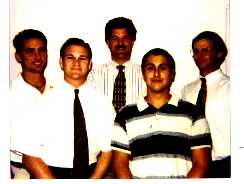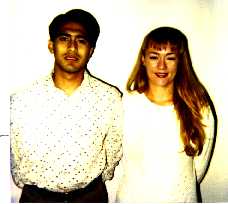Aquatic Exercise Program as an
Effective Alternative Method of Cross Training for Cross Country and Track Athlete
By Michael Mandas, P.T.; Andrew R. Einhorn, P.T.
C.S.M.T.; Jon Ellertson, B.S., P.T.A.; Shawn Hickling, B.S. Exercise Physiology; Kirsten
Pieters, B.S., Athletic Training; Michael Quinn; Gilbert Orbeso
of Los Alamitos Orthopaedic & Sports Physical
Therapy
 
PART III
AQUATIC CHONDROMALACIA WORKOUT(Knee Problems)
Beginning, Intermediate and Advanced chondromalacia exercises are
outlined below. Aquatic buoyancy assistive equipment may be used to decrease joint
compression in cross country and track athletes that present pain during exercise. In
asymptomatic athletes, resistance devices are added during the intermediate and advanced
phases of rehabilitation. Please refer to the equpment section of this article for further
description of each individual aquatic apparatus.
(Exercise progression to be individualized according to patellar
femoral symptoms.)
I. BEGINNING PHASE
A. Shallow H20
1. Walking forward/backward
2. Hamstring stretching
3. Hip PRE's (Individualize the amount of knee flexion or extension
range in each athlete to help minimize patellofemoral irritation)
B. Deep H20
1. High knees (limited R.O.M. at the hip and knee to prevent
patellofemoral irritation)
2. Cross-country ski (Individualize the amount of knee flexion or
extension range in each athlete to help minimize patellofemoral irritation)
II. INTERMEDIATE PHASE
A. Shallow H20
1. Walking forward/backward (with arm swings for resistance).
2. Hamstring stretches (continued)
3. Step-ups (low step)
4. R.O.M. for hip flexion/extension
5. Soccer-style kicking (for adduction)
6. Double leg hopping
7. Deceleration jumps
B. Deep H20
1. High knees (limited R.O.M. at the hip and knee to prevent
patellofemoral irritation)
2. Cross-country ski (individualize the amount of knee flexion or
extension range in each athlete to help minimize patellofemoral irritation)
3. Half jacks (Individualize the amount of knee flexion or extension
range in each athlete to help minimize patellofemoral irritation)
III. ADVANCED PHASE
A. Shallow H20
1. Walking forward/backward with arm swings for resistance.
2. Step-downs (low step) or step-ups (high step)
3. Hamstring stretching
4. Hip PRE's (flexion/extension with knee extension with resistive
device)
5. Skateboarding
6. Split jumps
7. Split jumps on step
8. Jump squats
9. Single leg hopping
B. Deep H20
1. High knees (with resistance)
2. Cross-country (with resistance)
3. Half jacks (with resistance)
4. Knee extension (thigh buoy is positioned superior to the knee
joints. Begin alternating knee flexion and extension movements from full extension to 50
degrees of knee flexion)
5. Burpees/Crunches
6. Wonderboard squatting
REHABILITATION FOLLOWING SHIN SPLITS AND STRESS
FRACTURES
I. BEGINNING PHASE
A. Shallow H20
1. Forward walking
2. Calf/hamstring stretching (as tolerated)
3. R.O.M. at the hip (flexion/extension)
4. Active R.O.M. at the ankle (plantar/dorsiflexion)
5. Step-ups (low step)
B. Deep H20
1. Cross-country ski
2. Half jacks (foot dorsiflexed)
II. INTERMEDIATE PHASE
A. Shallow H20
1. Walking forward/backwards
2. Side to side walking (short stride length)
3. Step-ups (low or high as tolerated)
4. Calf raises (double/single leg) or off low step for increased
R.O.M./strengthening)
5. Possible split jumps with varying strides or (double/single) leg
jump squats.
6. Hip ROM/PRE's
7. Active dorsi flexion/plantar flexion or calf pumps with fins
8. S.L.I.P.S. Progress as tolerated.
B. Deep H20
1. Cross-country ski progressing with increased active (dorsi/plantar
flexion)
2. Jogging progressing to running. Progress to buoyancy resistive
devices.
3. Half jacks
4. Scissors
5. Begin Circuit Training. Alternating legs and arms, combining deep
water running with upper extremity paddle movements. This exercise would be used after
each of the four exercises listed above. An example workout would include five minutes of
CC Ski followed by one minute of deep water running with upper extremity paddle movements.
This advanced workout increases cardiovascular endurance.
6. Burpees/Crunches
III. ADVANCED PHASE
A. Shallow H20 (vest is optional)
1. Walking backwards, side to side walking, crossovers and karioka
agility drills.
2. Stretches (gastrocnemiums, soleus and hamstring).
3. Hip/knee PRE's with fins progressing to hydrotone boots.
4. Ankle Proprioceptive Neuromuscular Facilitation patterns (PNF) (16),
with fins. Athlete will be sitting on a step with knee extended. First diagonal pattern is
dorsiflexion with eversion followed by plantar flexion with inversion.
5. The second diagonal pattern is dorsiflexion with inversion followed
by plantar flexion and eversion.
6. The final phase of PNF in a standing position combines hip, knee and
ankle movements. Exercise begins on a step while standing on the uninvolved leg. Place a
fin on the ipsilateral side and begin the following patterns of movement. Combine hip
adduction, flexion, external rotation with knee extension and ankle dori flexion. The
return pattern includes hip abduction, extension, internal rotation with knee extension
and ankle plantar flexion.
7. Skateboard. Fins may be used for strengthening.
8. Split jumps or double/single leg jump squats.
9. Double leg deceleration jump squats off a low step. Progress to a
single leg exercise.
10. SLIPS.
11. Single leg hopping, progress to side to side movements, zig zag
patterns and finally north/south/east/west directions with verbal cues from
therapist/coach.
12. Cross-country ski.
13. Running with increased intensity.
14. Scissors.
15. Circuit training for increased cardiovascular endurance.
16. Deep water squatting on wonderboard for advanced proprioception.
Terms:
PRE's Progressive Resistance Exercises
R.O.M. Range of motion
PNF Proprioceptive neuromuscular facilitation
SLIPS Single Leg Integrated Proprioception Skills
EQUIPMENT
Below is a list of companies, phone numbers and equipment that can be
used in an aquatic circuit training program.
Company Phone
Equipment
Hydro-Fit 1-800-346-7295
Buoyancy & Resistance Cuffs $49.95
Comfort Cuffs $9.95
Hand Buoys Regular/Jumbo $23.95
Sprint 1-800-235-2156
Wonderbard $59.95
Rothammer Peak Training Fin $27.99
Sports Chalet
Zoomers $34.99
Hydro-Tone 1-800-622-TONE
Vest $40.95
Boots $89.50
Bells $44.95
Aquatic 1-708-810-1717
Yellow Buoyancy Belts $17.00
Soft Vertical Float Cushion $22.00
Aquaflex Paddles $32.00
Aquatic Dumbbell Small/Lg. $23.00
Aquatic Dumbbell Triangle $32.00
Aquatic Dumbbell Square $32.00
REFERENCES
- 1. American Physical Therapy Association. Aquatic Physical Therapy: An
APTA Fact Sheet. Alexandria, VA.
-
- 2. Awbrey B. J., Dye K. K. Plunging into aquatic exercise: Walking in
Water. Training Conditioning, 1996.
-
- 3. Bates A., Hanson N. Aquatic Exercise Therapy. Philadelphia. W. B.
Saunders & Company, 1996.
-
- 4. Baretta R., Robergs, R. Physiological Adaptations to a 14 Week Deep
Water Exercise Program. Aquatic Physical Therapy Report: Vol. 3, 1995.
-
- 5. Brennan, D. K. Aqua running, no pain, much gain. Master Sports. 1992.
-
- 6. Fitness Swimmer: Get a little eccentric during your water workouts.
Summer, 1996.
-
- 7. Horsley, J. Personal Communication, 1996.
-
- 8. Hydro-Tone: The New Science of Total Fitness. Unpublished manuscript.
HydroTone Fitness System, Inc., Huntington Beach, CA.
-
- 9. Jamison L., Ogden, D. Aquatic Therapy Using PNF Patterns. Tucson.
Therapy Skill Builders, 1994.
-
- 10. Korel, L.E. The Properties of Water and Their Effect on Aquatic
Therapy. Athletic Therapy Today. 1 (2): 1996.
-
- 11. Newman, D.J. Moving Through Fluids. Biomechanics. May, 1995.
-
- 12. Napoletan, J. Aquatic Therapy: Overview. Rehab and Therapy Products
Review. Jan/Feb, 1995.
-
- 13. Templeton, M.S., Booth, D. L., O'Kelly, W. D. Effects of Aquatic
Therapy on Joint Flexibility and Functional Ability in Subjects with Rheumatic Disease.
JOSPT 23 (6): 1996.
-
- 14. Tovin, B. J., Wolf, S. L., Greenfield, B. H., et al. Comparison of
the effects of exercise in water and on land on the rehabilitation of patients with
intra-articular anterior cruciate ligament reconstructions. Phys. Ther. 74 (8): 1994.
-
- 15. Verstegen, M. Plunging into aquatic exercise: Underwater speed.
Training & Conditioning, 1996.
-
- 16. Voss, D. E., Ionta, M.K., Myers, B.J. Proprioceptive neuromuscular
facilitation patterns and techniques. Philadelphia, Harper and Row Publishers, 1985.
-
- 17. Wilder, R. P., Brennan, D., Schotte, D. E. A Standard Measure for
Exercise Prescription for Aqua Running. Am J Sp Med 21 (1): 1993.
International Copyright © of CoachesEducation.com. All Rights Reserved.
Reproduction in whole or in part in any form or medium without
express written permission
of CoachesEducation.com is strictly prohibited.
|
| ![]()




